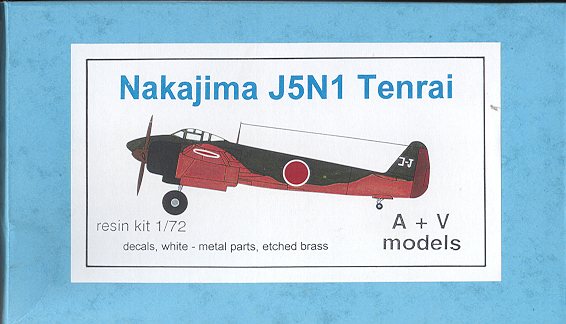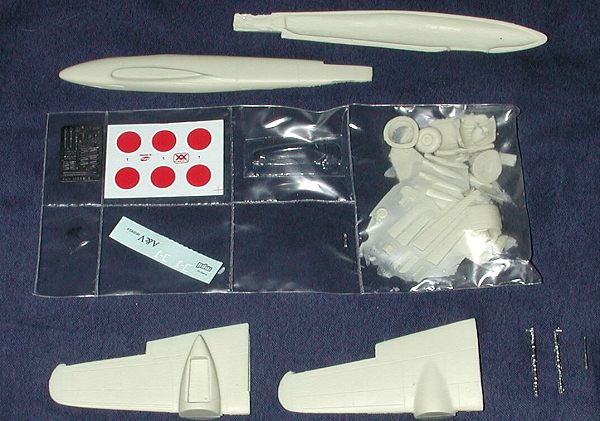
|
KIT: |
A+V Resin 1/72 J5N1 Tenrai |
|
KIT # |
|
|
PRICE: |
$36 AUD |
|
DECALS: |
One aircraft |
|
REVIEWER: |
|
|
NOTES: |
Resin with metal bits and vac canopy |

|
HISTORY |
The J5N1 Tenrai (Heavenly Thunder) was designed as a twin-engined, single seat interceptor capable of speeds in excess of 400 mph. The design work was started in 1943 and though it bore a strong resemblance to the J1N1, it was a much more powerful design. It relied on two 1,990 hp Homare 21 radials and was heavily armed with two 20mm and two 30mm cannon in the nose.
First flying in mid 1944, the design was disappointing in that it was unable to reach speeds much in excess of 320 mph. Though six prototypes were built, the last two being modified as twin seat aircraft, the design was dropped and the plan not put into production. Available photos of this plane are exceedingly difficult to find. Less than a handful have survived the war and those are of planes in less than pristine condition.
|
THE KIT |

A+V resins is one of a number of smaller Czech resin kit makers that produce interesting planes that would otherwise not see the light of day. The moldings are in a tan resin and have fairly good surface detail. It isn't so thin that it will disappear under paint and not the trenches one sometimes finds. There is a considerable amount of flash and roughness on the edges of the parts, but it is all within the standard range for resin kits.
There is some evidence of pinholes in a few of the parts, but no more than a dozen or so which is really quite good. Many of the smaller parts are embedded in resin 'wafers', again, a normal way to produce these bits. There is a single transparency that has no framework definition, a rather negative design feature, if you ask me, as masking this beastie will not be easy. There is also a generic etched metal fret more suitable for Luftwaffe kits as well as a basic decal sheet of roundels and code letters (not shown). Metal parts are provided for the main landing gear, control stick and pitot tube. They are of mediocre quality with quite a few pits in them that will be difficult to fill. However, they are welcome in that they will be able to hold up the weight of the kit.
All of these parts come in the compartmentalized bags that we have come to expect from Czech produced resin kits. On my example, the heavy parts (fuselage and wings) had broken free from the bag and were loosely in the box. Also loose in the box were the metal landing gear and pitot tube.
Instructions are quite basic, but adequate. It includes a nice three view
drawing, an exploded parts assembly section and a separate sheet with color
diagrams. An interesting feature is that the kit includes separate ailerons, but
not separate rudder or elevators. Most unusual.
|
CONCLUSIONS |
Well, one doesn't expect to find super high quality with most resin kits. This one is better than most in terms of overall detailing and should make into a very nice model. It is thanks to folks like A+V that these types of aircraft are available to us who like the more esoteric for our aircraft.
If you would like your product reviewed fairly and quickly where it will be seen by well over 150,000 visitors a month, please contact me or see other details in the Note to Contributors.